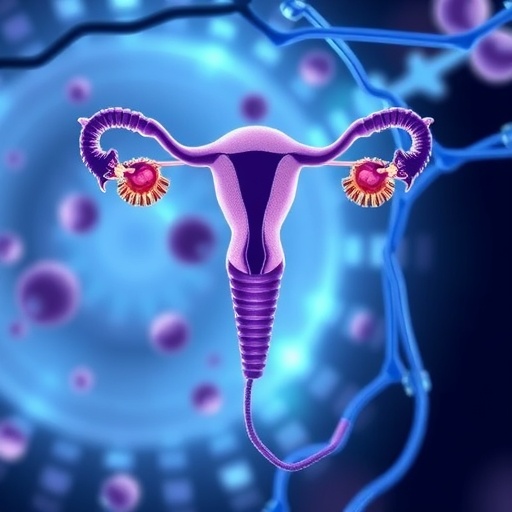
In a groundbreaking study, the researchers Ma, Zhu, and Xie explore the intricate biochemical pathways underpinning the treatment of premature ovarian insufficiency (POI) using the traditional Chinese medicinal formulation known as Ningxin-Tongyu-Zishen. Their findings have the potential to reshape our understanding of hormonal regulation and offer new avenues for therapeutic interventions. At the heart of this research is the subtle yet vital balance between two neurotrophic factors: pro-brain-derived neurotrophic factor (proBDNF) and mature brain-derived neurotrophic factor (mBDNF). The study draws attention to the PAI-1/tPA signaling pathway, a lesser-known yet critical player in this biochemical ballet.
Premature ovarian insufficiency is a condition that affects countless women worldwide, leading to hormonal imbalances and reproductive challenges. Conventional treatments typically focus on hormone replacement therapy, but these approaches may not address the underlying mechanisms contributing to POI. In contrast, the Ningxin-Tongyu-Zishen formula, rooted in centuries of herbal medicine, offers a holistic approach that warrants scientific validation. By uncovering the molecular mechanisms through which this formula influences proBDNF and mBDNF levels, the researchers aim to unveil a novel therapeutic strategy for women suffering from POI.
The balance between proBDNF and mBDNF is crucial to the health of ovarian function. While proBDNF primarily regulates cellular processes that encourage neural development, mBDNF is associated with enhancing survival and function in mature neurons, crucial for overall reproductive health. The researchers propose that disturbances in this balance may contribute to the symptoms and physiological manifestations of POI. Therefore, understanding how the Ningxin-Tongyu-Zishen formula modulates this dynamic could reveal why traditional Chinese medicine has garnered attention for treating such complex hormonal disorders.
In their research, Ma and colleagues investigated the roles of PAI-1 (plasminogen activator inhibitor-1) and tPA (tissue plasminogen activator) in the ovarian environment, where they discovered that these two proteins are modulated by the Ningxin-Tongyu-Zishen formula. Their results indicate that the formula may downregulate PAI-1 levels while promoting the activity of tPA, swinging the balance toward healthier levels of mBDNF. This biochemical shift could ultimately enhance ovarian function and thus, fertility in women facing POI.
Furthermore, the study delves into the implications of these findings on female reproductive health. With the rising incidence of premature ovarian insufficiency due to factors such as increased stress levels and environmental toxins, innovative treatments are urgently needed. The research suggests that through its influence on the PAI-1/tPA signaling pathway, the Ningxin-Tongyu-Zishen formula not only mitigates the symptoms associated with POI but potentially reverses some of the hormonal imbalances that characterize this condition.
The methodology of the study is significant and noteworthy. The researchers employed a combination of biochemical assays, animal models, and possibly genomic analysis to establish the correlation between the herbal formula’s application and the levels of proBDNF and mBDNF. This multi-faceted approach lends credibility to their findings, allowing for a comprehensive understanding of the pathways at play. It reaffirms the importance of integrating modern scientific methods with traditional herbal practices to validate and enhance their effectiveness.
The therapeutic implications of modulating the PAI-1/tPA pathway extend beyond solely the treatment of POI. Emerging evidence suggests that this pathway may play a role in various reproductive disorders, thus providing generalizability to the findings of this study. Should the results from the Ningxin-Tongyu-Zishen research translate effectively into clinical settings, they could potentially herald a new era in reproductive medicine. Future studies could expand these findings to evaluate the effectiveness of this formula across different populations and demographic groups.
In the larger context of women’s health, this research could serve as a pivotal point where traditional medicine meets modern biochemistry. It emphasizes the necessity for further research into herbal remedies, pointing toward a future where multi-faceted treatment approaches could become the norm. As scientists continue to unravel the complex signals that influence reproductive health, traditional formulas like Ningxin-Tongyu-Zishen might not only complement existing therapies but also illuminate new treatment paradigms.
The research conducted by Ma, Zhu, and Xie embodies the ongoing quest to innovate within the field of reproductive medicine. By understanding the biochemical interactions and pathways that govern reproductive health, medical professionals may someday provide women with comprehensive solutions tailored to their specific conditions. This integrative approach represents a convergence of the old and the new, ultimately aimed at improving the quality of life for countless women around the world.
Such insights also beckon deeper inquiries into the mechanisms through which other traditional herbal remedies affect reproductive health. The findings concerning Ningxin-Tongyu-Zishen could motivate more extensive research into artisanal formulations, examining their impacts on various conditions affecting women’s health. This study exemplifies how curiosity-based inquiry can lead to significant advancements in therapeutic strategies and foster a broader appreciation for ethnopharmacology.
As methodologies evolve and our understanding of intricate biological pathways expands, the potential for developing targeted treatments that respond to women’s unique health challenges becomes increasingly attainable. Researchers and medical practitioners alike have a shared responsibility to continue investigating the blends between traditional practices and contemporary science, paving the road toward innovative healthcare solutions grounded in an evidence-based approach.
In conclusion, the seminal study by Ma, Zhu, and Xie not only articulates the potential of traditional Chinese medicinal formulations in treating modern medical issues but also advocates for a holistic view of health. By emphasizing the importance of neurotrophic factors in ovarian function, the study presents a transformative narrative around premature ovarian insufficiency. This research catalyzes further exploration into the complex interplay between herbal medicine and modern biological science, fostering a sophisticated understanding of treatments that empower women facing the challenges of reproductive health. The journey ahead remains filled with promise, as we are just beginning to scratch the surface of what is possible when ancient wisdom merges with contemporary scientific inquiry.
Subject of Research: The mechanism of Ningxin-Tongyu-Zishen formula regulating probdnf/mbdnf balance through PAI-1/tPA signaling pathway in the treatment of premature ovarian insufficiency.
Article Title: The mechanism of Ningxin-Tongyu-Zishen formula regulating probdnf/mbdnf balance through PAI-1/tPA signaling pathway in the treatment of premature ovarian insufficiency.
Article References:
Ma, J., Zhu, C., Xie, L. et al. The mechanism of Ningxin-Tongyu-Zishen formula regulating probdnf/mbdnf balance through PAI-1/tPA signaling pathway in the treatment of premature ovarian insufficiency. J Ovarian Res 18, 184 (2025). https://doi.org/10.1186/s13048-025-01769-1
Image Credits: AI Generated
DOI: 10.1186/s13048-025-01769-1
Keywords: Premature ovarian insufficiency, Ningxin-Tongyu-Zishen, proBDNF, mBDNF, PAI-1, tPA, herbal medicine, reproductive health.
Tags: Biochemical pathways in reproductive healthHerbal medicine and reproductive challengesHormonal regulation in ovarian healthNeurotrophic factors in ovarian functionNingxin-Tongyu-Zishen formulaNovel therapeutic strategies for POIpremature ovarian insufficiency treatmentProBDNF and mBDNF balanceRegulating PAI-1/tPA pathwayScientific validation of herbal treatmentsTraditional Chinese medicine for POIWomen’s health and hormonal imbalances




